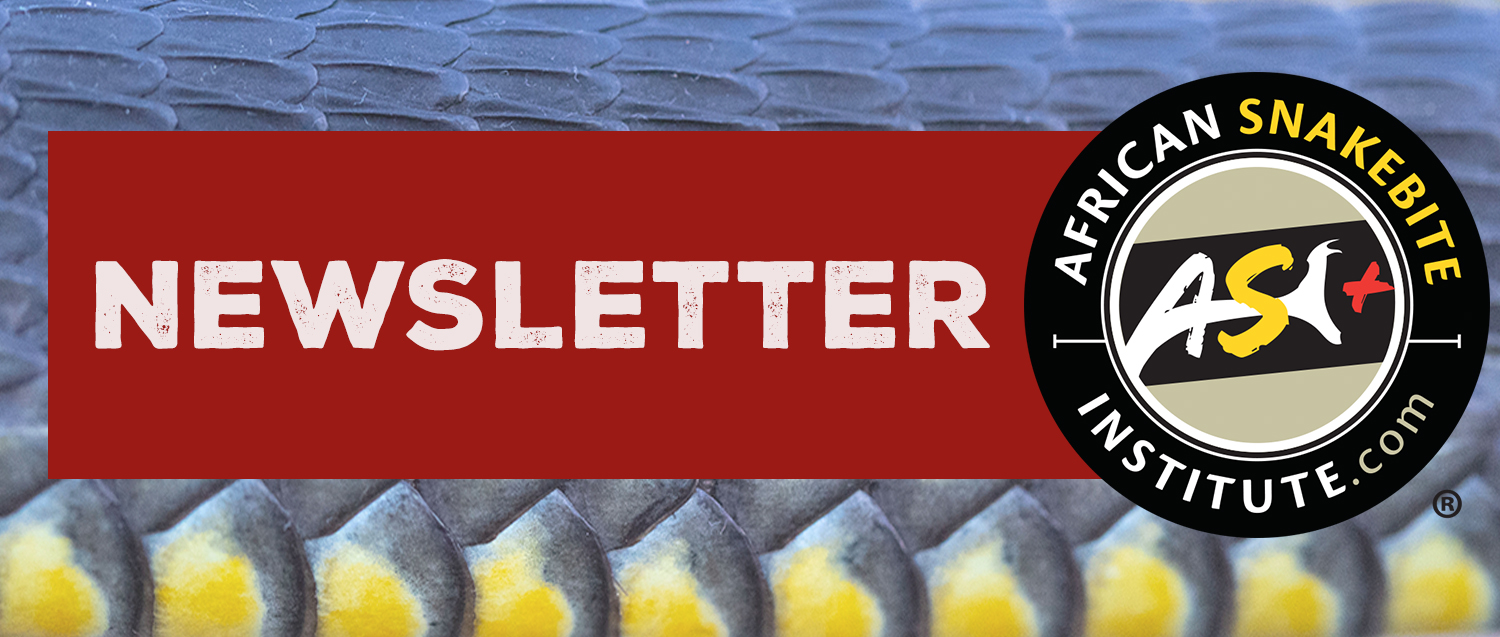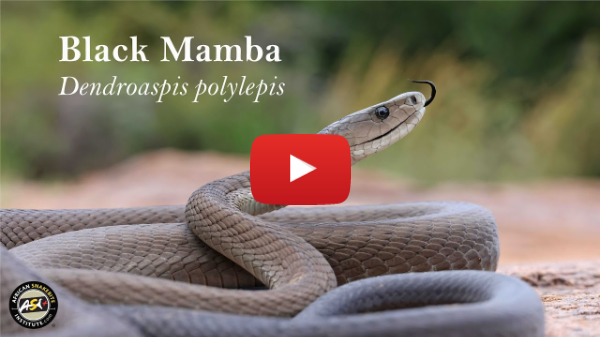|
You are receiving this email because you signed up for the monthly ASI Newsletter.
If you no longer wish to receive these emails you can unsubscribe here
|
 |
|
September 2024 - Where did the Black Mamba get its name?
|
|
|
|
Common names of snakes, and other reptiles for that matter, are often confusing. As there are no rules when it comes to common names, various names are often used to refer to a single species. You can call any reptile whatever you want, but you might be the only person that does so. For this reason, all living things have scientific names.
There are rules when it comes to describing snakes, and each species has a genus and a species name, usually written in Latin or Ancient Greek. These names are used universal, no matter what language you speak. When referring to Naja nivea, scientists and lay people will know that you are talking about the Cape Cobra, first described in 1758 by Linnaeus, the father of taxonomy. It is also called a Koper Kapel, Bakkopslang, Bruin Kapel or Geelslang but in the North West Province farmers may refer to the Snouted Cobra (Naja annulifera) as a Geelslang. It gets even more confusing as the Snouted Cobra used to be a subspecies of the Egyptian Cobra (Naja haje) but was elevated to a full species by the late Dr Don Broadley in 1995 and the common name Egyptian Cobra was dropped.
|
 |
|
Egyptian Cobra (Naja haje) from Kenya. Egyptian Cobras occur from northern Tanzania northwards whereas Snouted Cobras occur from Zambia southwards.
|
|
|
Snakes & Snakebite in Southern Africa
An essential guide to identifying all dangerous snakes in the region, as well as several commonly encountered harmless snakes.
Now fully revised and expanded, this third edition includes nine additional species, over 250 new photographs, and the latest medical information.
Simple icons, distribution maps, succinct text and full-colour photographs make this a clear, practical and easy-to-use guide.
A comprehensive aid for all those with outdoor interests.
Price R280.00
|
| Order here |
|
|
|
We have a Common or Rhombic Night Adder (Causus rhombeatus) that is largely active during the day and a grass snake called the Skaapsteker (Psammophylax rhombeatus and P. tritaeniatus), the latter blamed for sheep deaths in the Eastern Cape hundreds of years ago, but its venom is mild and cannot harm a sheep. These common names are so well entrenched that it will be pointless to try and change them. The Cape File Snake, (Limaformosa capensis), is not found in the Cape and is now referred to as the Common File Snake. The name “Cape” likely referred to where the snake was shipped from “Cape of good hope – Cape Town” when specimens were sent to European museums.
|
 |
|
The Common File Snake used to be known as the Cape File Snake although it does not occur in any of the Cape Provinces.
|
|
|
|
As for the Black Mamba, both the Green Mamba (Dendroaspis angusticeps) and the Black Mamba (Dendroaspis polylepis) were considered the same snake. It was thought that they started green and later darkened with age. It was only in 1946 that the late Desmond FitzSimons, then curator of FitzSimons Snake Park in Durban, noticed several differences between the two snakes and alerted his brother Vivian FitzSimons of his observations. The two mambas in southern Africa were then described as different species.
The word iMamba has a Zulu origin, but in Swahili ‘mamba’ refers to the crocodile. As for its colour, the Black Mamba varies in colour, but is rarely black or even very dark. Juveniles are light grey to olive, darkening with age to olive green, dark olive, greyish brown or gunmetal grey, with darker posterior mottling that may form oblique bars. The belly is usually lighter than the body, with faint dark mottling
|
 |
|
A dark Black Mamba from Limpopo.
|
|
Personally, I have never seen a Black Mamba anywhere near black, despite having worked with hundreds of individuals over the past 45 years. I have seen the odd darkish individual, especially specimens that were about to shed, but they are few and far between. Central Namibia has some of the darkest mambas which may be near black towards the tail.
|
|
|
|
|
|
I spoke to Nick Evans who has dealt with well over 1,000 Black Mambas in the greater Durban area over the past 10 years, and he has never seen one anywhere near black. Byron Zimmerman, who removes snakes in the Hillcrest area, has dealt with more than 450 Black Mambas in the past 15 years and he has never encountered one anywhere near black.
In his book Snakes of Rhodesia (1975) Don Broadley states that the name Black Mamba is misleading as most specimens are brown or grey. He also mentions that the name is too well established to change but suggests Brown Mamba or Black-mouthed Mamba.
|
 |
|
Black Mambas are known for the dark, inky-black mouth.
|
|
Charles Pitman, in his book A Guide to the Snakes of Uganda (1974) also states that black is a misnomer. R.C.H. Sweeney, in his book Snakes of Nyasaland (1961) uses the common name Black-mouthed Mamba and states the following: ‘This snake is often called “Black” Mamba in English and is well-known by this name, but since all forms are not even dark in colour and no truly back specimens have ever been recorded, I prefer to use the common name given above’.
So where does the name Black Mamba come from? In my book Complete Guide to Snakes of Southern Africa I mention that it is supposedly derived from the colour of the inside of the mouth, which is an inky black. Some herpetologists go along with that, but others disagree.
I discussed this with my colleague Luke Kemp who came up with another idea. The first Black Mamba (Dendroaspis polylepis) was described by Günther back in 1864. The individual used for the description (the ‘type’) would have been fixed in formalin and then preserved in alcohol and shipped to Europe awaiting further investigation and description. We know that preserved specimens often go dark in colour and there is a good chance that this was the case. For now, we will certainly stick with ‘Black Mamba’.
Johan Marais
CEO – African Snakebite Institute
|
|
|
|
|
 |
|
View more videos online here.
|
|
|
|
ASI Rangers Combo
ASI Rangers Combo includes:
JM150 Snake Tong (Red)
ASI PRO Snake Hook
750 mm snake tube
Safety Goggles for Spitting Snakes
4 x First Aid for Snakebite Booklet
2 x A1 Snakes of Southern Africa Poster
2 x A1 Medically Important Snakes of Southern Africa Poster
Price R2460.00
|
| Order here |
|
|
|
|
|
HOEDSPRUIT
Snake Awareness, First Aid for Snakebite and Venomous Snake Handling Course
Date: Saturday 05 October 2024
Venue: Southern Cross Schools, Raptors View, Hoedspruit
|
|
|
| Book here |
|
|
|
HOEDSPRUIT
Venomous Snake Handling Bootcamp
Date: Sunday 06 October 2024
Venue: Southern Cross Schools, Raptors View, Hoedspruit
|
|
|
| Book here |
|
|
|
KIMBERLEY
Snake Awareness, First Aid for Snakebite and Venomous Snake Handling Course
Date: Saturday 12 October 2024
Venue: McGregor Museum, Kimberley
|
|
|
| Book here |
|
|
|
KIMBERLEY
Venomous Snake Handling Bootcamp
Date: Sunday 13 October 2024
Venue: McGregor Museum, Kimberley
|
|
|
| Book here |
|
|
|
WESTERN CAPE
KLAPMUTS
Snake Awareness, First Aid for Snakebite and Venomous Snake Handling Course
Date: Saturday 19 October 2024
Venue: Exotic Animal World, Klapmuts
|
|
|
| Book here |
|
|
|
WESTERN CAPE
KLAPMUTS
Venomous Snake Handling Bootcamp
Date: Sunday 20 October 2024
Venue: Exotic Animal World, Klapmuts
|
|
|
| Book here |
|
|
|
WESTERN CAPE
KLAPMUTS
Kids' Snake Awareness Course
Date: Sunday 20 October 2024
Venue: Exotic Animal World, Klapmuts
|
|
|
| Book here |
|
|
|
GAUTENG
MULDERSDRIFT
Snake Awareness, First Aid for Snakebite and Venomous Snake Handling Course
Date: Saturday 26 October 2024
Venue: Cradle Moon Lakeside Lodge, Muldersdrift
|
|
|
| Book here |
|
|
|
GAUTENG
MULDERSDRIFT
FREE Kids Snake Awareness Session
Date: Saturday 26 October 2024
Venue: Cradle Moon Lakeside Lodge, Muldersdrift
|
|
|
| Book here |
|
|
|
GAUTENG
MULDERSDRIFT
Venomous Snake Handling Course
Date: Sunday 27 October 2024
Venue: Cradle Moon Lakeside Lodge, Muldersdrift
|
|
|
| Book here |
|
|
|
|
|
|
|
Johan Marais is the author of various books on reptiles including the best-seller A Complete Guide to Snakes of Southern Africa. He is a popular public speaker and offers a variety of courses including Snake Awareness, Scorpion Awareness and Venomous Snake Handling. Johan is accredited by the International Society of Zoological Sciences (ISZS) and is a and SASTM (South African Society of Travel Medicine) - approved service provider. His courses are also accredited by the HPCSA (Health Professions Council of South Africa). Johan is a qualified instructor for the Emergency Care & Safety Institute in Oxygen Administration and Wilderness First Aid and a qualified Basic Life Support instructor.
|
 |
|
Copyright © 2024 African Snakebite Institute, All rights reserved.
Our mailing address is:
admin@asiorg.co.za
unsubscribe from this list
|
|
|
|
|